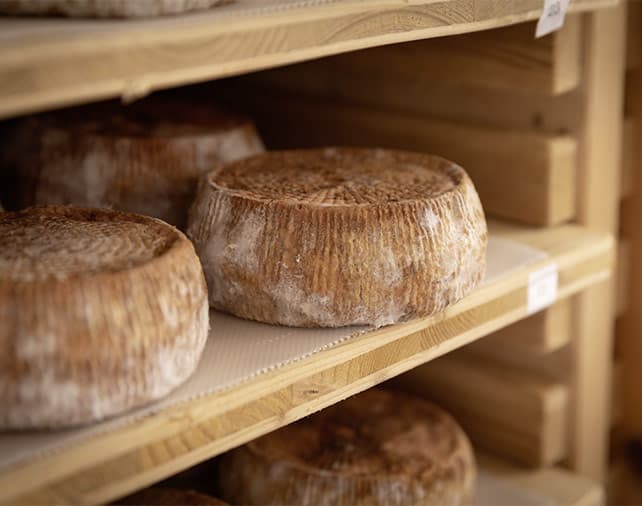
Ripening
This one word encapsulates our ambition as cheese ripeners: getting the timing exactly right to bring our customers cheeses at the peak of their flavour.
The cellars
A good quality cheese will ripen successfully in an environment worthy of it, developing its complex flavours to their full potential.
But it can only achieve this in a ripening cellar. This is no sterile cold store, but a living environment where successive generations of cheeses have left an invisible yet essential footprint: their flora. Each cellar has its own flora, which suits specific cheeses and develops what we call the cellar “atmosphere”. This atmosphere is palpable, in terms of the humidity level, warmth or coolness in the cellar and can also be detected through the relentless invisible work of the micro-organisms to build the flora.
Constantly for several decades, our cellars have been developing this living environment and ensuring it thrives. It’s their greatest asset; the secret of the cellars, the precious tools of our trade.



The skills
Providing a suitable environment is vital, but tending to the cheeses is no less important.
Initially, the cheeses are laid on spruce wood boards. Then, they are moved into the appropriate cellar. If necessary, they may even travel between cellars. Some begin with some time in a maturing room, whereas others go straight to the cellars to ripen.
They are then all turned regularly to ensure that they ripen evenly. Some, such as Saint-Nectaire, need to be brushed dry, whereas others, such as Munster, are rubbed with water. Large cheeses with good keeping qualities such as Beaufort have to be brushed regularly to rid them of the mites that flourish on the rind. Each cheese needs its own special treatment, more or less often depending on the precise requirements.
While there is nothing particularly complicated about the work that is carried out day to day in our cellars, the cheeses need constant attention and considerable ongoing work.
To monitor our products as they develop, we rely on our senses – sight, touch, smell and taste – to guide us each day, because however experienced the ripener, raw milk cheeses are fragile and sometimes unpredictable. They force us to admit with humility that we do not always control everything. Even though they are created by people, these are living products and sometimes they call the shots.
Raw milk
When milk is pasteurised, all the flora made up of micro-organisms is removed, leaving a bland liquid. Raw milk is different: it retains all its rich flora, which forms the essence and the soul of the very best cheeses.
While out of necessity we do have one or two types of pasteurised cheese in our cellar, the immense majority of the cheeses we ripen are made of raw milk. Without them, there would be no call for artisan cheese ripeners. These products tell of their origins, from the valleys or mountains where they came into being to the vaults under which they forged their characters. They don’t just age, they slowly ripen until they reach their peak and are ready to be enjoyed.


